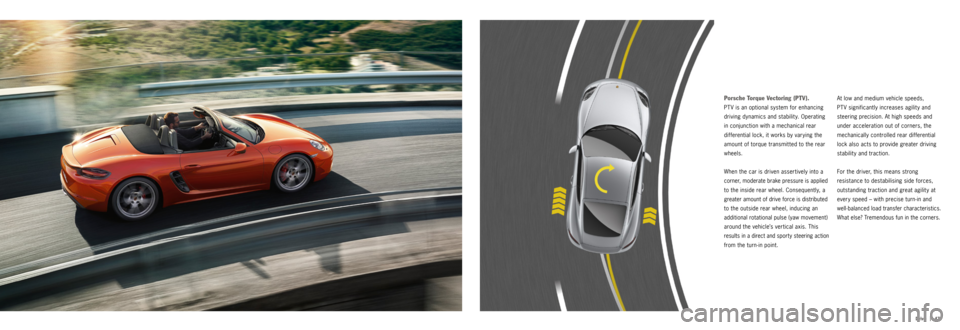traction control PORSCHE 718 2016 1.G Information Manual
[x] Cancel search | Manufacturer: PORSCHE, Model Year: 2016, Model line: 718, Model: PORSCHE 718 2016 1.GPages: 75, PDF Size: 19.11 MB
Page 23 of 75

| 47
Drive
At low and medium vehicle speeds,
PTV significantly increases agility and
steering precision. At high speeds and
under acceleration out of corners, the
mechanically controlled rear differential
lock also acts to provide greater driving
stability and traction.
For the driver, this means strong
resistance to destabilising side forces,
outstanding traction and great agility at
every speed – with precise turn-in and
well-balanced load transfer characteristics.
What else? Tremendous fun in the corners.
Porsche Torque Vectoring (PTV).
PT V is an optional system for enhancing
driving dynamics and stability. Operating
in conjunction with a mechanical rear
differential lock, it works by varying the
amount of torque transmitted to the rear
wheels.
When the car is driven assertively into a
corner, moderate brake pressure is applied
to the inside rear wheel. Consequently, a
greater amount of drive force is distributed
to the outside rear wheel, inducing an
additional rotational pulse (yaw movement)
around the vehicle’s vertical axis. This
results in a direct and sport y steering action
from the turn-in point.
Page 25 of 75

50 |
Chassis
Porsche Stability Management (PSM).
The new 718 Boxster and 718 Cayman
models are equipped with enhanced
Porsche Stabilit y Management (PSM) – an
automatic control system for maintaining
stability at the limits of dynamic driving
performance.
PSM improves traction under acceleration
on inconsistent road surfaces. The result
is a high level of driving stabilit y and
safety – and extraordinary agility at the
same time.
Porsche Active Suspension
Management (PASM).
Optional PASM, the electronic damping
control system, continuously adjusts the
damping force on each wheel, based on
current road conditions and driving style.
In addition, the body sits 10 mm lower.
PASM has t wo modes, which can be
selected using a separate button on the
centre console: ‘Normal’, which is a blend
of performance and comfort, and ‘Sport ’
where the setup is much firmer.
The results are tangible: increased driving
stability, improved comfort and enhanced
performance.
Anyone can follow the straight and narrow.
Only the corner is the true test of mettle.
Only in the corner does a sports car really
become a sports car. So it’s all the more
important to have a chassis that can
master any sporting challenge. And be a
match for the high power output of the
engine.
The axle components are for the most
part made of aluminium, which keeps the
vehicle weight and unsprung masses low.
The wide track, long wheelbase and
specific chassis construction help to
deliver particularly precise and agile
handling.
Expansive plains. Endlessly long, straight highways.
Best to steer clear.
Chassis.